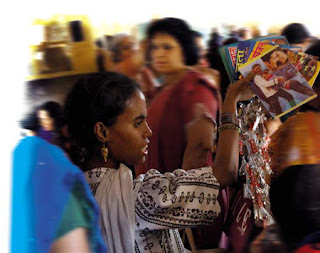The constant vibration,
the loud clatter, the high-pitched calls, the elbow hit, sometimes the feet
stamping, the irrefutable wind blowing, the urge to just fall asleep, the
tiredness, the unbearable body odour, the restricted space, and the chhuuk-chhuuk-chhuuk-chhuuk…
Mumbai’s Local Train is an experience everyone dreads to
undertake.
I was a kid when I first saw the local trains. Excitement bubbled
inside me like boiled water on stove, I wanted to experience the maddening
thrill of chasing a speeding train and climbing into it. That thrill evaporated
the moment I experienced it. My love for local trains has reduced to negative in
the last seven months. Now it’s a necessity— speed and convenience, that’s it.
But I can’t refute the fact that local trains continue to be the nervous system
of this magnanimous city. Today, it is responsible for daily commutation of
more than 7.24 million people and has the largest passenger density in the
whole world.
Have you ever just sat idly(that is if you get a seat!) and
observed the insides of a local train? If yes, you know what I’m talking about.
If no, well, you are missing something! There is a pool of versatility pouncing
on you, literally. Rich or poor, educated or uneducated, young or old, student
or professional, you name it, these trains have it. It has an amazing power of
bonding people of all classes together. Marathi, Gujrati, Hindi and English, I
hear a mixture of all these languages regularly.
Not only diversity, but locals present a whole range of
human mentalities too. In ladies coach, you find these ladies who stubbornly refuse
to move even an inch when your station arrives, ladies shouting loudly and
gossiping, but sometimes, ladies who readily help you unload your luggage from
train too.
But what I’m going to talk here is about the two most
interesting elements of local trains- its instant markets and advertorial
opportunities. Even in an extremely packed train, brave hawkers squeeze their
way in and hang their items in steel holders for display. What is even more fascinating
is that women (such shopping freaks they are!) take out time to carefully
scrutinize and buy these items. Imagine a very crowded compartment, women
sweating, some sitting, and most of them standing. Now imagine those who are
standing have their one hand firmly clutched around the metal holders hanging
from the top, and with their other hand, which they tactfully squeeze through
the crowd, they sift through the items. Not only this, they even manage to bargain
and buy it with a satisfied smile. Looking, bargaining and buying, all that in
those extremely packed spaces; spaces in which I can’t even breath!
This is just the beginning. Now comes the part about advertorial
opportunities. In the inside walls, plastered on ceiling, doors, windows and
walls are print advertisements- not the normal ones we get to see on TV or
magazines, but some innovative ones. The one I can never forget goes like this:
“Samasya hai to samadhan bhi hai.
Khula challenge 7 ghante me 100% laabh guarantee ke sath, aapki
manokaamna 100% purn hogi jaise- naukri, karobaar me laabh, karzmukti, prem
vivah, manchahi shaadi, kisi ne kuch khilaya pilaya ho, sautan pareshani,
talaak, grah klesh, court matter, filmo me safalta, santaan prapti, lakshmi
bandhan, muthkarni. Call Baba Ahmed Khan”
Now that is an advertisement! A poor unemployed fellow will
surely try this out. After all ‘7 hours’ sounds so tempting. I was almost on
the verge of calling this baba up, just to check whether its’s true! Not only
this, there are many more ads. “Earn money at home” or “Join a call center” and
the list continues.
It is amazing how a
transportation device has been harnessed to its full capacity in all respects,
not only in terms of ads, but also in terms of its space. The local trains display
a capacity of maximum 85 passengers in one coach. Once I tried to count, and
after counting till 97 I gave up. It was too jammed pack! I realized then, the
magnitude of population explosion our country is facing. Every inch is being
used up!
And as I sit now, writing my blog in yet another local train
(this one is less crowded so I can use my laptop here!), I realize its
necessity in Mumbai. People thrive on locals. Mumbai grew exponentially because
it had locals to connect even its remotest part. This city would have been just
another city, had local trains not spread its nerves in every part of it. What
is commendable is the fact that special compartments are allotted for
handicapped people. And a cherry on cake-- a policeman stands on guard in
ladies coach at night! I sit here alone in the compartment with just another
policeman, and I know Western Railways will ensure my safety.
Mumbai will get handicapped without its locals, and so will
we!









